One of the great things about staying pretty much in one neighborhood is that as I walk around doing the eternal mundane little things of life — which are just as mundane here as anywhere else, I’m sorry to say — I sometimes have the sensation of being carried along on a gentle current of badinage. Sometimes it’s complaining, sometimes not, but the art of quip and banter has been honed here to a comfortable edge that doesn’t draw blood. It depends on your tone of voice.
It’s a skill you’d expect to find developed in any small area where people have known each other for a long time (convent, factory, school, office, etc.) and can’t really avoid each other.
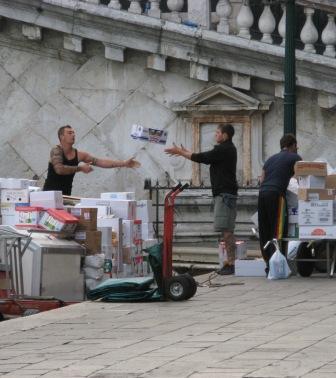
This morning we went into the pharmacy; someone was there to get something for a strained muscle. After some conversation about this item or that, he decided, paid, and turned to leave. “I don’t know,” grumbled the client/patient, somewhat loudly, “it seems like I’ve got just one pain after another.”
Filippo the pharmacist has undoubtedly heard this far too many times. “Pains are like money,” he bounced back: “The more you’ve got, the more you keep.” Was that comforting, or did laughing just make the person feel better? I wonder if they teach you these witticisms in pharmacy school. I hope not. I’d rather think he made it up.
We moved on to the butcher shop, where the ever-smiling Marcello was doing his usual micro-surgery on shapeless masses of meat. It’s kind of hypnotic to watch him work, using just the right knife of just the right length and shape and sharpness, deftly stripping away strata of fat and dislodging inappropriate pieces of bone.
He smiled at us. “By now the knife can do it all by itself,” he said, smiling at our fascination.
“Well, you need hands that know what they’re doing,” Lino remarked.
“Sure,” Marcello replied. “But after 50 years, it’s like there are little eyes on the point of the knife.” A self-guiding butcher knife; a knifebot. I like it.
Then there are plays on words. I realize this may be hopelessly hard to explain, but I heard it just yesterday, and not for the first time — a minor quip that was probably funny the first ten times or so, back in 1329. You might need to have already had a few to find it amusing anymore. Here goes:
“La porta” means “the door.” “La” also means “she,” or “you” addressed to a female. “Porta” can also mean “bring” or “carry.”
So on the vaporetto, it is happening more and more often that someone entering or leaving doesn’t shut the sliding door. In the winter, this is rude and also kind of dumb (is it not obvious that these doors aren’t automatic?? Does the freezing wind somehow not touch that person?). These will be the same people — or their relatives — who, when we are suffocating with heat and humidity in the depths of July, will make a point of closing the door.
But it’s winter, and the door’s open, and sometimes a person (Venetian) near the door will just get up and close it. Or sometimes an exasperated passenger will call out to the offending party: “La porta!” (The door!)
To which someone else (Venetian), feeling frivolous, might respond: “Un litro!” (A liter). Saying this has instantly shifted the scene from a frigid, real vaporetto to a warm and stuffy imaginary osteria, where the men clustered around a table playing cards would be very likely utter the same exclamation, but in this case “A liter” means “Bring us a liter of wine.”
Maybe I’ve crushed the humor, but thought I’d give it a try. I think it’s funny.
Then there was the other morning. I was standing in line at the cash register at the little super-low-price supermarket wedged back into a corner of the campo behind and beyond us, a remote locale not far from the geographical frontier past which there are only sea monsters, just before you drop off the edge of the world.
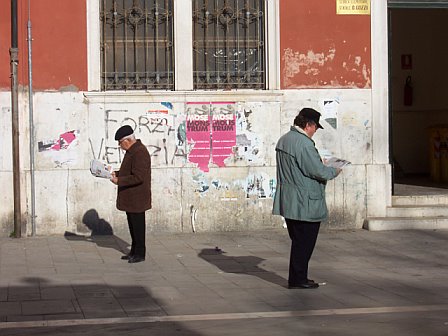
The man in front of me, a grizzled, generic sort of retired working-class dude, had put his few items on the conveyor belt and the young man at the cash register had picked up one of them, a small plastic bottle of honey. I tuned in at the moment when the cashier had decided (I don’t know why) that he needed to explain how the nozzle-top worked. Perhaps the man had inquired, though he didn’t look like the type that would even have noticed it had a nozzle. Or cared.
“So you just take off the top, like this,” the cashier was saying, “and turn it over, and squeeze, and out comes just however much you need,”
“Oh this isn’t for me,” the man replied. God forbid anyone should think he had degenerated to the point of eating honey. “This stuff is for my wife.”
“So you don’t eat anything calling for honey in the morning?” the cashier confirmed in a friendly way.
“God no,” the man said. “I have a mortadella sandwich and a glass of red wine.”
This makes me smile. First, because it’s kind of a distinctive breakfast concept (I’m guessing it would be the “Canal-Dredger’s Special” on the coffeehouse menu). And second, because it sounded normal. Not good, not healthy, not to be recommended under any circumstances — but totally normal. Not only do I know that this is absolutely what he would have been expected to have in the morning (mortadella, being probably the cheapest cold cut you can get, sometimes goes by the nickname of the “plasterer’s prosciutto”). I don’t even see anything … how can I put this … wrong with it. I mean, I wouldn’t have it — but I wouldn’t not have it, either.
When you can look at something and grasp it as being both weird and normal, you’ve been wherever you are for too long. If I were a police officer they’d long since have rotated me out, sent me somewhere on the dark side of Sardinia. But here I am.

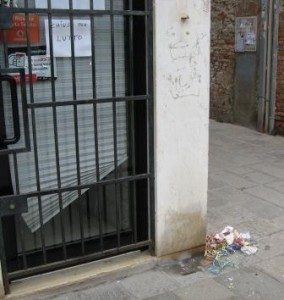


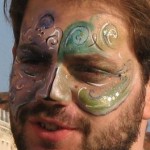
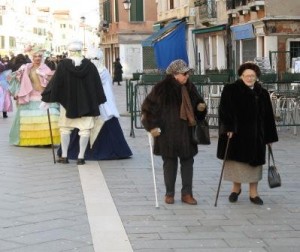
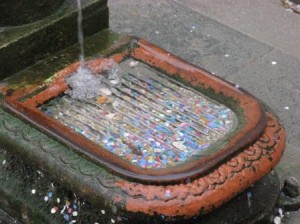


 The white mask often called a bauta is more correctly termed “Volto“ (face) or “Larva.” Sounds repellent, but it comes from the Latin meaning ghost, specter, minor evil spirit. Its extraordinary shape resolves several important concerns: First, it completely hides the face; second, it leaves space for the wearer to eat and drink; third, its shape alters the speaker’s voice, thereby acting as a kind of vocal, as well as visual, disguise.
The white mask often called a bauta is more correctly termed “Volto“ (face) or “Larva.” Sounds repellent, but it comes from the Latin meaning ghost, specter, minor evil spirit. Its extraordinary shape resolves several important concerns: First, it completely hides the face; second, it leaves space for the wearer to eat and drink; third, its shape alters the speaker’s voice, thereby acting as a kind of vocal, as well as visual, disguise.  I think my favorite is the “Moretta,” or “Servetta Muta.” It’s so strange it could only have come from France (it did), and it started out, at least, as something to be worn by women when they went to visit a convent. It was usually made of black velvet, and wasn’t attached by ribbons; you kept it on your face by biting down on a small button attached to the faceward side. (Hence the term “mute.”)
I think my favorite is the “Moretta,” or “Servetta Muta.” It’s so strange it could only have come from France (it did), and it started out, at least, as something to be worn by women when they went to visit a convent. It was usually made of black velvet, and wasn’t attached by ribbons; you kept it on your face by biting down on a small button attached to the faceward side. (Hence the term “mute.”) 